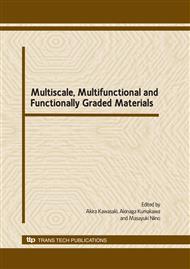p.41
p.47
p.53
p.59
p.65
p.73
p.79
p.85
p.91
Mixture Screening Design to Choose Formulations for Functionally Graded Fiber Cements
Abstract:
This work employing the screening strategy to examine thirteen mix proportions of six-component fiber cement formulations composed of ordinary Portland cement, ultra-fine cement, limestone filler, silica fume, cellulose and polyvinyl alcohol fibers. The vacuum de-watering technique was applied in the production of fiber cement specimens cured for 10 days and submitted to four-point bending tests. The mechanical properties such as limit of proportionality (LOP), modulus of elasticity (MOE), modulus of rupture (MOR) and specific energy (SE) were evaluated and these properties were correlated with the raw material fractions resulting in mixture rules. Results indicate that screening can be a promising methodology with which to generate coherent fiber cement mixture rules, optimize formulations in terms of costs and performance and even facilitate the choosing of formulations for functionally graded fiber cements.
Info:
Periodical:
Pages:
65-70
Citation:
Online since:
October 2009
Price:
Сopyright:
© 2010 Trans Tech Publications Ltd. All Rights Reserved
Share:
Citation:


